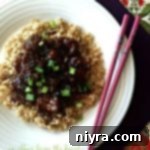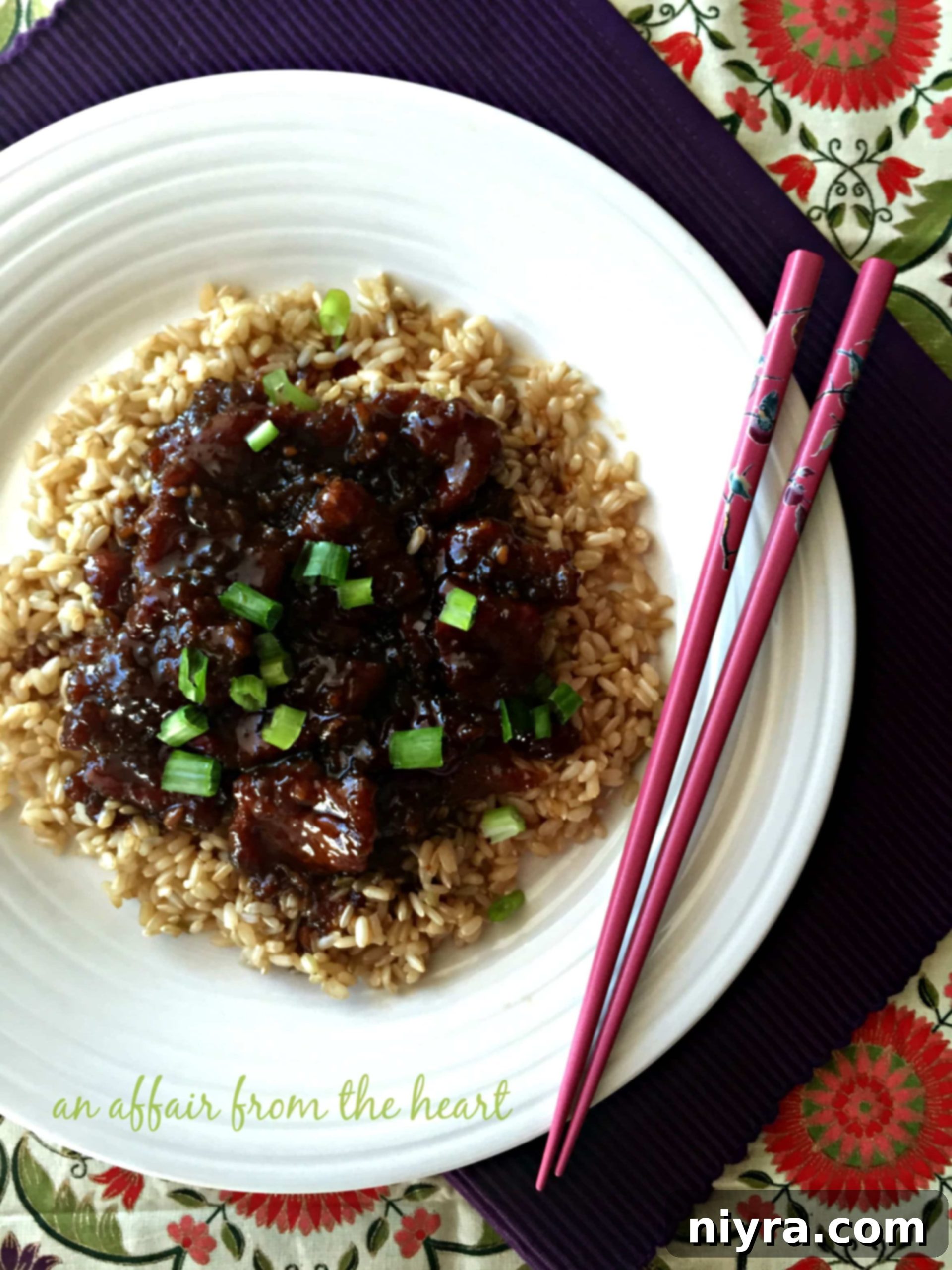Unlock the Secret: Master P.F. Chang’s Mongolian Beef at Home!
There’s something undeniably captivating about a perfectly prepared Mongolian Beef. That succulent, tender steak coated in a glistening, sweet, and savory sauce, often with a hint of ginger and garlic, served piping hot over fluffy rice. For many, P.F. Chang’s has set the benchmark for this classic dish, making it a go-to order during dining out or takeout nights. But what if we told you that the exquisite flavors and textures you adore could be replicated right in your own kitchen? Imagine enjoying that restaurant-quality experience without the need for reservations or delivery fees.
For a long time, my relationship with Chinese food was strictly “takeout.” It was my culinary escape, a deserved break from cooking that I cherished. However, a recent conversation with my dear friend, Brandi, the brilliant mind behind Aunt Bee’s Recipes, completely shifted my perspective. I often marvel at the creativity and dedication of food bloggers, and Brandi is truly one of the best. Curiosity led me to ask her a challenging question: “What is your absolute favorite recipe on your blog?” For a food blogger, this is akin to asking a parent to pick a favorite child – an impossible task! Yet, after much deliberation, she confidently chose her Mongolian Beef recipe. Knowing Brandi’s culinary prowess and having successfully tried her recipes before, I knew this was a dish I had to bring to my family’s table.
Brandi’s recipes have become trusted favorites in my household. Her Southwest Chicken Linguine, for instance, instantly became a family hit and has been recreated countless times. It’s a testament to her ability to craft dishes that are both approachable and incredibly flavorful. Beyond main courses, her knack for creating delightful treats is equally impressive. Just recently, I whipped up her Ham & Cheese Sliders (keep an eye out for a dedicated post on those soon!), and a few weeks prior, her individual Peanut Butter Mug Cookie For One. As my friend Jill always says when a sweet craving hits, it’s “the perfect little cookie or something” when you just need a small, satisfying treat. Brandi’s recipes are consistently winners, promising delicious results every time.
Why Make P.F. Chang’s Mongolian Beef at Home?
Recreating your favorite restaurant dishes at home offers numerous benefits. Firstly, it’s significantly more cost-effective. Dining out or ordering takeout frequently can quickly add up, whereas buying ingredients in bulk and cooking from scratch allows you to enjoy gourmet meals for a fraction of the price. Secondly, you gain complete control over the ingredients. This means you can opt for higher quality cuts of meat, organic vegetables, and adjust sodium or sugar levels to suit your dietary preferences. For instance, using low-sodium soy sauce is a simple swap that makes a big difference in this recipe.
Moreover, the satisfaction of preparing a dish that rivals your favorite restaurant is immense. It transforms a simple meal into an accomplishment, a skill learned and mastered. It also provides the flexibility to customize. Want more spice? Add a pinch of red pepper flakes. Prefer extra vegetables? Toss in some bell peppers or snap peas. The kitchen becomes your canvas, and you, the culinary artist.
Unveiling the Secrets to Perfect Mongolian Beef
While I admit I’m typically a Broccoli Beef loyalist when I visit P.F. Chang’s, the feedback on Brandi’s Mongolian Beef is unanimous: it tastes just like the restaurant version. This success hinges on a couple of crucial techniques that Brandi meticulously shared. These aren’t just tips; they are the game-changers that elevate this homemade dish from good to extraordinary.
The first secret lies in the humble cornstarch. Before cooking, each piece of beef is lightly dusted with cornstarch and allowed to rest for a period. This step, which I initially found surprising, is absolutely brilliant. It works wonders by creating a delicate, crispy crust on the beef when fried, which then locks in moisture, resulting in incredibly tender meat. Furthermore, this coating helps the savory sauce adhere beautifully to every morsel, ensuring an explosion of flavor in every bite. This is precisely how restaurants achieve that signature texture that makes Mongolian Beef so irresistible.
The second, equally vital, tip from Brandi is to avoid crowding the pan while cooking the meat. When too much beef is added to the skillet at once, the temperature of the oil drops significantly. Instead of searing, the meat ends up steaming, leading to a dull, gray exterior and a less desirable texture. To achieve that beautiful brown, slightly crispy sear, it’s essential to cook the beef in multiple small batches. Even with my large electric skillet, I found it necessary to cook the meat in two separate batches. This ensures each piece has enough space to cook evenly and develop that perfect exterior, preventing it from sticking together and maintaining its individual integrity.
Crafting the Signature Sauce and Perfect Sides
The sauce for Mongolian Beef is a symphony of sweet and savory. It begins with aromatics – fresh ginger and garlic – quickly sautéed to release their fragrant oils. Then, a blend of low-sodium soy sauce and water forms the liquid base, which is brought to life with a generous amount of dark brown sugar. Whisking the brown sugar until fully dissolved and allowing the sauce to simmer and thicken for a few minutes is crucial. This creates that luxurious, glossy coating that beautifully envelops the tender beef.
Once the beef is perfectly cooked and drained, it’s reunited with this magical sauce and simmered for another ten minutes, allowing all the flavors to meld and deepen. The result is a dish that is robust, balanced, and utterly delicious.
No Mongolian Beef feast is complete without the right accompaniments. Brandi wisely suggests serving it over steamed white rice, which provides the perfect canvas for the flavorful beef and sauce. To ensure you get your essential greens, she recommends a side of her Fresh Ginger and Garlic Roasted Broccoli. As for me, a passionate mushroom lover, I often opt for a simple stir-fry of broccoli and mushrooms on the side, adding another layer of texture and earthiness to the meal. You could also include steamed green beans, sautéed bell peppers, or even a simple fresh salad for a complete and wholesome meal.
Embracing the joy of cooking at home has been a truly rewarding experience, especially when guided by talented friends like Brandi. This Copycat P.F. Chang’s Mongolian Beef is more than just a recipe; it’s an invitation to elevate your weeknight meals and impress your family and friends with a dish that tastes like it came straight from your favorite Asian restaurant. Thank you, Aunt Bee, for consistently sharing such incredible recipes – I’m already looking forward to my next culinary adventure from your blog!
LOVE THIS RECIPE?
Don’t forget to give it a ⭐️⭐️⭐️⭐️⭐️ star rating and
leave a comment below the recipe!

Rated 5 out of 5 stars by 1 user.
Print Recipe
Copy Cat P.F. Chang’s Mongolian Beef
Ingredients
- 4 teaspoons vegetable oil + 1 cup for frying
- 1 teaspoon ginger minced
- 2 Tablespoons garlic chopped
- 1 cup LOW SODIUM soy sauce
- 1 cup water
- 1 1/2 cups dark brown sugar
- 2 pounds top sirloin or flank steak trimmed of fat and gristle and sliced against the grain
- 1/2 cup cornstarch
- Green Onions Chopped
- Rice cooked
Instructions
- Trim fat and gristle from the beef and slice it against the grain into thin strips. Dip each steak piece thoroughly in the cornstarch, ensuring an even coating, and let it sit for 30 minutes so the cornstarch adheres well to the meat.
- While the beef rests, prepare the sauce. Heat 4 teaspoons of vegetable oil in a large saucepan over medium heat. Add the minced ginger and chopped garlic, stirring constantly for 1 minute until fragrant. Immediately add the low-sodium soy sauce and water to prevent the garlic from burning.
- Whisk the dark brown sugar into the sauce mixture until it completely dissolves. Increase the heat to bring the sauce to a boil, then reduce slightly and simmer for 2-3 minutes, stirring constantly, until the sauce visibly thickens. Remove the saucepan from the heat and set aside.
- After the beef has rested for 30 minutes, heat 1 cup of vegetable oil in a large skillet or wok over medium-high heat. The oil should be hot but not smoking. Carefully add the cornstarch-coated beef to the pan in batches, making sure not to overcrowd the pan. Each piece needs enough room to brown properly. Sauté the beef for about 2 minutes per side, or until it develops a slight brown crust. (It will finish cooking in the sauce.) Use a slotted spoon to remove the cooked meat from the pan and transfer it to a plate lined with paper towels to drain excess oil. Repeat with remaining beef.
- Carefully drain and clean the oil out of the skillet. Return the cooked beef to the clean skillet, then pour in the reserved sauce. Simmer the beef in the sauce for 10 minutes, allowing the flavors to meld and the beef to fully absorb the delicious sauce.
- Serve the Mongolian Beef hot over cooked rice, generously sprinkled with fresh chopped green onions for a burst of color and mild onion flavor.
Notes
Nutrition
—
View Aunt Bee’s Original Recipe Here!
—
